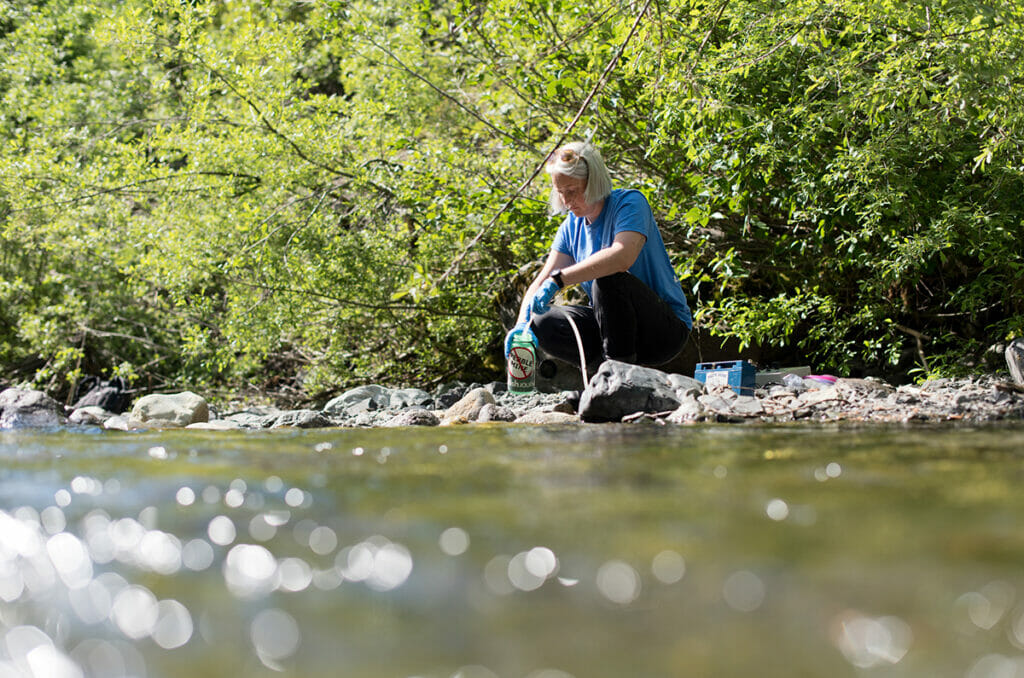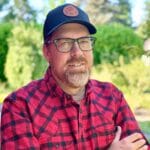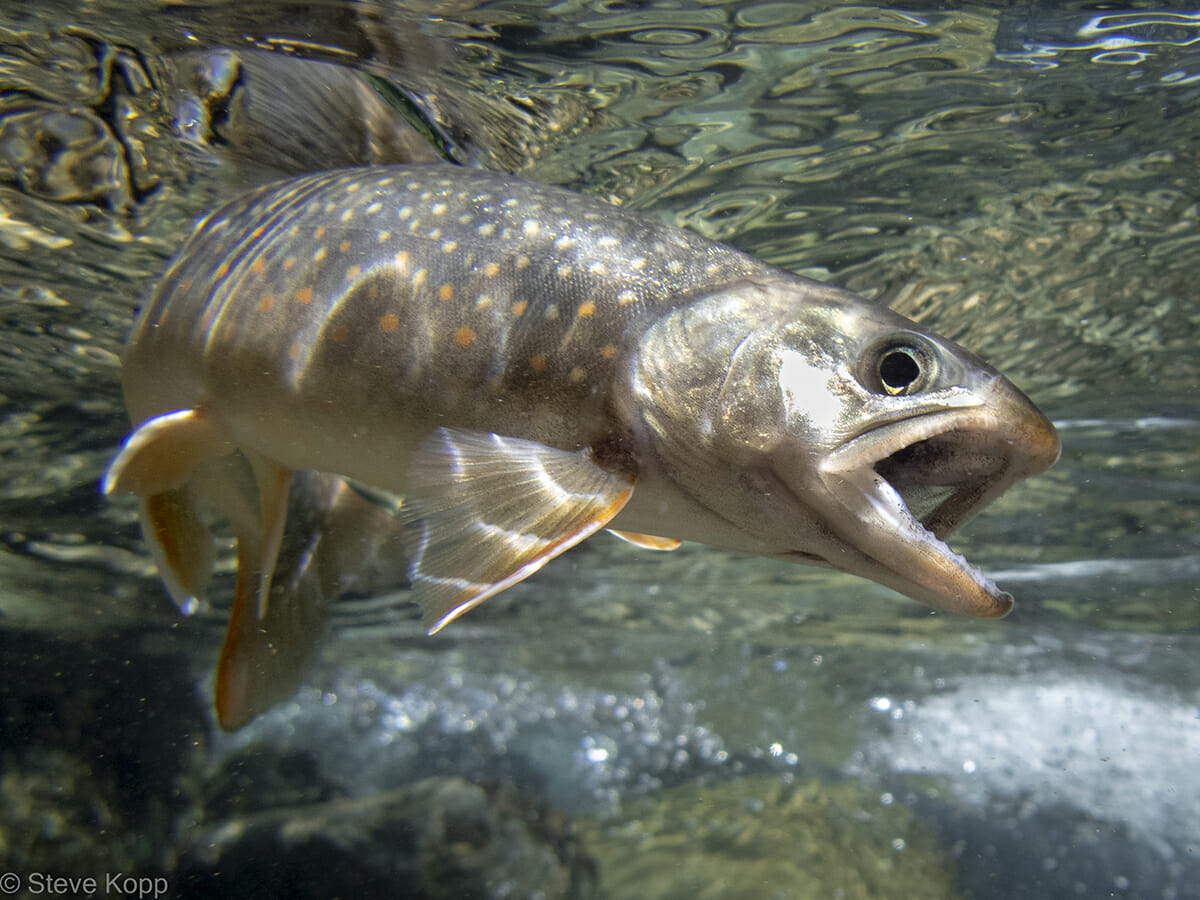A volunteer chapter in Washington State is going the distance to collect trout and salmon eDNA samples in their home water
Fed by glaciers and deep snowpack, the Nooksack River joins the Pacific Ocean near Bellingham, Washington, a half-hour drive south of the Canadian border. Upstream, the basin’s cold headwaters originate high in the Cascade Mountains and the river’s three primary forks – the North, Middle, and South – span across the Mount Baker Wilderness. This deeply remote, thickly-forested corner of the Pacific Northwest is home to native salmon, trout, and char, and maybe – just maybe, depending on who you ask – might also be home to the mythical Sasquatch.
“Dollysquatch 2.0,”a new film from The Flyfish Journal and Trout Unlimited, follows Bridget Moran, the president of North Sound chapter of Trout Unlimited, and Copi Vojta, the magazine’s photo editor, as they bike up an abandoned and washed-out road along a key Nooksack tributary seeking evidence of Dolly Varden, a native char, with fly rods and specialized equipment used to test the creek’s water for traces of Environmental DNA (eDNA).
The film is a sequel to an earlier Flyfish Journal film (“Finding Dollysquatch”) highlighting the chapter’s three-year volunteer-led effort to sample 300 locations throughout the Nooksack basin and provide comprehensive documentation of fish distribution throughout the watershed.
North Sound TU samples streams for Environmental DNA
Spearheaded by Moran and Steve Kopp, North Sound TU’s advocacy chair and manager of the eDNA project, the project grew out of an existing U.S. Forest Service effort to document bull trout population ranges, and their spawning and rearing habitat, in the Lower 48. The Nooksack River presents a unique challenge because it also contains native populations of Dolly Varden and non-native Eastern brook trout. When an eDNA test became available that could identify the three species of char separately—thereby offering a chance to distinguish where in the basin the populations overlapped and where they remained separate—the chapter jumped at the opportunity to mobilize volunteers to collect the necessary data.
North Sound TU bought two sets of collection equipment, and in 2020 began sampling to identify the boundaries of Nooksack char populations. Soon afterward, the chapter won funding through Trout Unlimited’s Embrace-A-Stream program that allowed them to work with the Forest Service’s National Genomics Center for Wildlife and Fish Conservation to develop a new eDNA test that greatly expanded the number of species counted. That meant they could also test for all five species of native salmon, rainbow trout (and steelhead), cutthroat, and pacific lamprey, in addition to the three char species.
“The infusion of cash provided by the Embrace-A-Stream program was a huge boost for the program,” Moran explained. “I think our ability to talk about a wider range of species in the watershed helped create more enthusiasm and interest around the project in our community. That enthusiasm helped recruit more volunteers and supporters. People could see the positive impact the project would have.”
This comprehensive data set will offer important insights into fish populations and key habitats across the Nooksack watershed. It also made additional collaborations possible. For example, adding testing to identify the presence of pacific lamprey meant that North Sound could partner with the Pacific Lamprey Conservation Initiative to identify additional testing locations, including a few in the nearby Skagit River basin, and share new population information for this struggling, native coldwater species.

After three years of work, sampling is nearly complete. Volunteers are scrambling to get as many of the last sites documented before winter—and the Pacific NW’s infamous rain—arrive. Just last week, Kopp had finally finished three days of sampling in some of the last, rugged locations in the basin. Soon the final samples will be run through the labs at the National Genomics Center and the data will be overlaid onto new maps of the Nooksack. The data gathered by these citizen scientists will inform a new report intended to help guide management and conservation of char, and other coldwater species, in the watershed.
Angler science and volunteer leadership helps track elusive fish species
Kopp’s tireless work has made the project run. He was the one who originally reached out to the Forest Service. He did the training to learn how to use the equipment properly and still teaches every volunteer in a one-to-one session. A GIS specialist by profession, he developed custom maps and taught volunteers how to correctly identify sampling locations. He sought permission from private landowners and timber companies, reached out to local tribes for insights, rallied funding sponsors, gave public presentations, and recruited and organized volunteers.
For the past three years he has been responsible for maintaining and delivering the equipment, collecting the samples, and shipping them to the National Genomics Center for testing.
“The project is really his baby,” Moran explained.
Kopp says it’s the perfect job for someone who considered himself a “fish and map nerd.” He is quick to shift credit to the dedicated volunteers and noted that while some of the best were TU members, the project had also captured the attention of a wider community. Many were anglers, some were college students, and others were retirees. They all shared an interest in the fish and water of the Nooksack Basin and were eager for an opportunity to contribute to a wider understanding of the watershed’s fish populations.
“Interestingly,” he said, “When I talk to the volunteers after they’ve been involved, they always tell me that they had a great day in the field, no matter how difficult it was. They talk about the places on the river they had a chance to see that they might not have otherwise. After contributing to the project, they come away with a greater appreciation and awareness of what is out there and why it is so important.”
Watch “Dollysquatch 2.0” and read The Flyfish Journal blog post
Learn more about North Sound TU’s eDNA project at the chapter’s website
Watch the previous video in the series, “Finding Dollysquatch”



